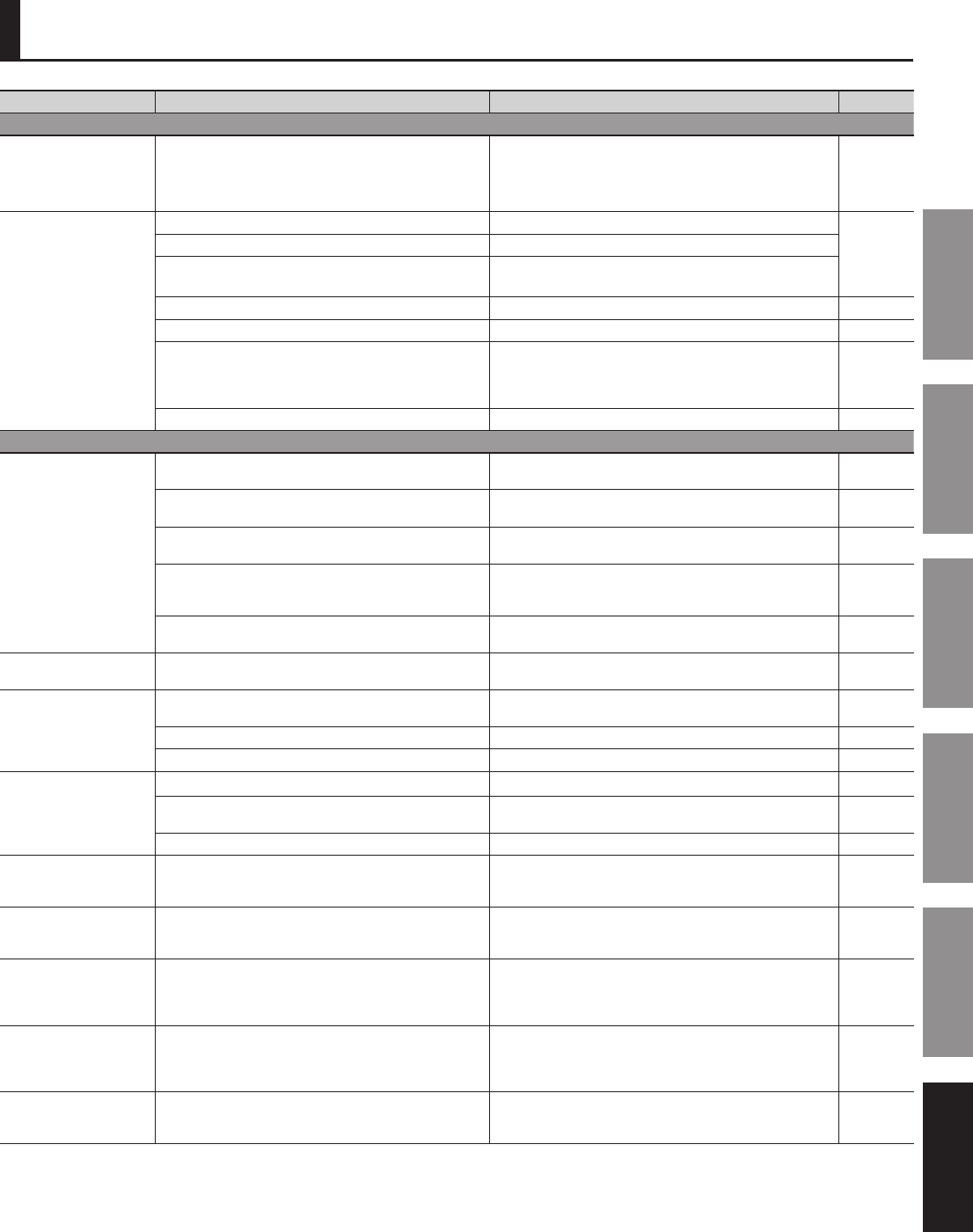
99
Introduction Playing Sounds Editing Sounds
Other Convenient
Functions
Connecting Other
Equipment
Appendix
Troubleshooting
Problem Items to check Action Page
Overall problems
Power won’t turn on
Are the included AC adaptor and power cord correctly
connected to an outlet and to the JUPITER-80?
Check that the power cord is connected correctly.
Do not use any AC adaptor or power cord other than the
supplied items.
Doing so will cause malfunctions.
p. 20
No sound
Have the connected amp or speakers been powered up? Turn on the power of the connected amp or speakers.
p. 23
Could the volume of a connected device have been lowered? Adjust the volume of the connected equipment.
Could the [VOLUME] knob be set to the minimum level? Adjust the [VOLUME] knob.
Could the MASTER EQ’s Level setting be too low? Check the MASTER EQ’s Level setting. p. 85
Are your amp, speakers, headphones, etc., connected correctly? Correctly connect your amp, speakers, and headphones. p. 20
Can you connect headphones and hear sound through them?
If you hear sound through your headphones, it may be that there
is a broken connection cable, or that your amp or mixer have
malfunctioned. Check your connection cables and equipment
once again.
p. 20
Could you be using a connection cable that contains a resistor? Use a connection cable that does not contain a resistor. —
Problems with the Synthesizer sound
No sound
If pressing the keyboard does not produce sound, could the
Local switch be turned o?
Turn the Local Switch setting on. p. 84
Could the level setting be too low?
Check the Registration level, Part level, and the level of the Live
Set layer.
p. 37, p. 58
Are the eect settings correct?
Check the eect on/o settings. Also check settings such as the
eect levels.
p. 59
Could the volume have been lowered by a pedal operation,
a D Beam controller operation, or a MIDI message (volume or
expression) received from an external MIDI device?
Step on the pedal, move your hand above the D Beam controller,
and check settings of the other controllers.
p. 47, p. 48
Could the PART [PERC]/[LOWER]/[UPPER]/[SOLO] buttons or
layer buttons be turned o?
Turn on the [PERC]/[LOWER]/[UPPER]/[SOLO] buttons. p. 37, p. 58
No sound from a specic
range of keys
Could a key range be set?
If you don’t hear sound from a specic range of keys, check the
key range settings.
p. 39
Sound is distorted
Could you be applying an eect that intentionally distorts the
sound?
If the sound of a specic Part or Live Set layer is distorted, lower
the volume for that Part or Live Set layer.
p. 37, p. 58
Could the [VOLUME] knob be set too high? If the overall sound is distorted, lower the [VOLUME] knob. p. 18
Could the Output Gain be raised excessively? Check the system setting “SOUND”. p. 84
Pitch is wrong
Could the JUPITER-80’s tuning be incorrect? Check the system setting “Master Tune”. p. 84
Could the pitch have been changed by a pedal operation or by
a pitch bend message received from an external MIDI device?
Check the pedal and the pitch bender. p. 47, p. 48
Could the Coarse Tune or Fine Tune parameters be set? Check the Coarse Tune and Fine Tune settings. —
Notes are broken o
Notes will be interrupted if more than 256 notes are sounded
simultaneously.
Reduce the number of layers in the Live Set you’re using.
Increase the voice reserve setting for layers in which notes must
not drop out.
p. 58
Notes remain sounding
when you play the
keyboard
Could the polarity of the hold pedal be reversed? Check the system setting “Hold Pedal Polarity”. p. 83
Sound is still heard from
the opposite side as well
even when panned all the
way to one side
Could eects be applied?
Since the JUPITER-80’s internal eects are stereo, applying
an insert eect will allow eect sound to be heard from the
opposite side even if the source sound is panned all the way to
one side.
—
Notes played in a high
register sound funny
When you play high notes on the JUPITER-80, you might hear
notes that fail to sound, whose pitch fails to rise, or a noise that
changes depending on the note you play (a warbling, chirping,
rustling, beeping, etc.)
This is usually because you have exceeded the highest note
that the JUPITER-80 is able to produce, and won’t occur with
the notes you would normally use. This does not indicate a
malfunction.
—
Changing the tempo does
not aect the arpeggio
tempo or delay time
Could the system setting “USB Song Sync Mode” have been set
to “SLAVE”?
If “Sync Mode” is set to “SLAVE,” change the tempo of the external
device that is transmitting MIDI clock data.
p. 86


















